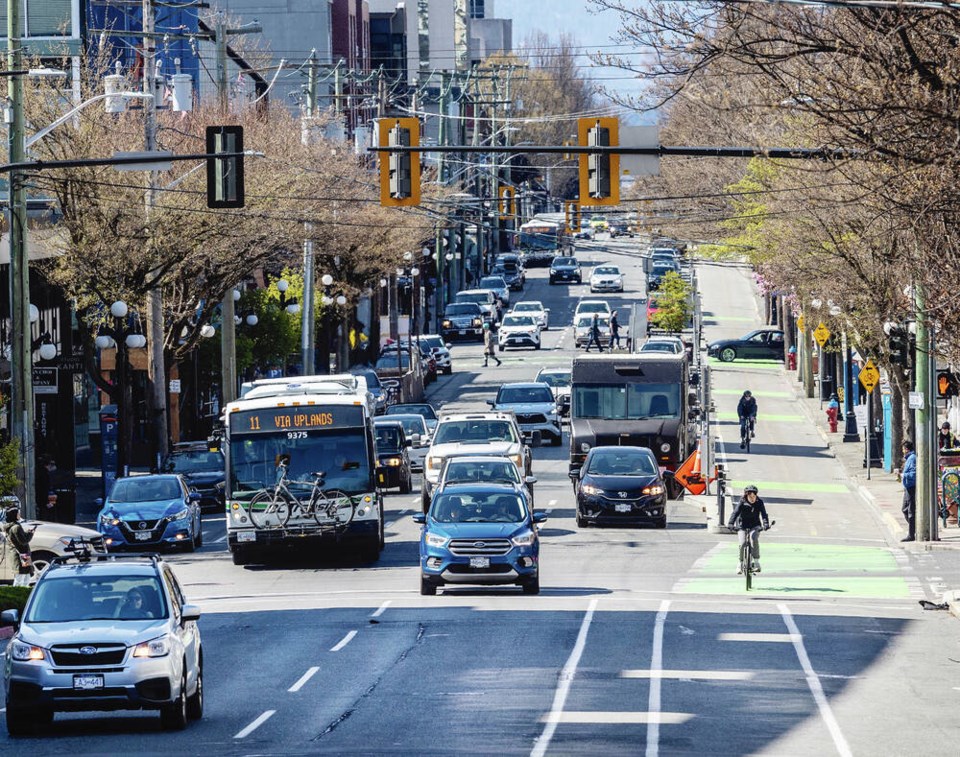A commentary by the executive director of the Victoria Transport Policy Institute. He can be reached at [email protected].
There have been noisy complaints against Victoria’s bikeways. Critics call them unnecessary, ineffective, and a “vanity project.”
This is inaccurate and unfair. Abundant research shows that bikeways improve safety, increase walking and bicycling, reduce traffic problems, and save money overall.
I can report from personal experience that bikeways make our city better for people and animals. I often walk with our dog, Sarita, on Vancouver Street, one of Victoria’s bicycle boulevards.
It is wonderful! There is a steady stream of pedestrians, leashed pets and bicyclists, plus occasional low-speed car traffic.
This reflects good urban planning. Cities are, by definition, places where many people and activities occur close together.
This proximity locates common destinations – shops, schools, parks and jobs — within convenient walking and biking distance so residents save time and money, are safer and healthier, generate less pollution, minimize infrastructure costs, and have friendly interactions their neighbours.
Last month, Forbes Magazine ranked Victoria one of the world’s best places to visit.
Why? According to the magazine’s travel writer, “One of the unexpected joys of living in the Pacific Northwest turned out to be frequent jaunts to charming Victoria. I love the ease of this compact, walkable city.”
Compact walkability is our most valuable asset!
Excessive vehicle traffic threatens those benefits. Too many cars driving fast and demanding abundant parking spoil our urban paradise.
For safety and livability, our streets must favour walking, bicycling and public transit over cars.
Every time somebody purchases an automobile they expect governments and businesses to spend thousands of dollars each year on roads and parking facilities for their use.
This costs far, far more than sidewalks and bikeways for walking and bicycling. Automobiles also impose congestion, crash risk, noise and air pollution; if we want to reduce those problems, we need to reduce urban traffic.
When motorists oppose lower speed limits, they are demanding to impose delay and risk on other road users. When motorists oppose parking fees, they are demanding large subsidies. When motorists oppose bikeway investments they are demanding an excessive share of public infrastructure.
Pedestrian and bicycling projects ensure that non-drivers receive our fair share of investments.
According to the Capital Regional District’s travel survey, more than 90 per cent of residents walk or bike at least occasionally; 20 per cent of Victoria households are car-free; residents own more bicycles than cars; and bicycle travel is increasing.
Local and provincial governments have targets to double walking, bicycling and transit trips, and reduce automobile travel to achieve our affordability, health and environmental goals.
Success will require reprioritizing infrastructure investments.
Communities around the world are becoming more walkable and bikeable. The European Union requires all cities to implement Sustainable Urban Mobility Plans.
Paris is a good success story: by improving non-auto modes and removing parking spaces, it reduced vehicle traffic 60 per cent in the central city and 35 per cent in suburbs.
The results are so popular that Mayor Anne Hidalgo was reelected after vowing to further remove cars and support non-motorized travel. Once people experience effective traffic reductions, they love it!
Critics may be skeptical, so let’s make this interesting.
According to the most recent regional travel survey, in 2017, seven per cent of Victoria trips were by bicycle. The Capital Regional District is performing a new travel survey.
I wager $100 that the results will show that Victoria’s bicycle mode share increased during the past five years. If you really consider bikeway investments ineffective, put your money on the barrel.
However, that it would be a fool’s bet. Around the world, bicycling is growing as people discover its benefits and e-bikes expand potential trips.
Bikeway investments and traffic speed reductions are improving non-auto travel. We can expect more walking, bicycling and transit travel in the future.
This is good news because everybody benefits from a more affordable and efficient transportation system, including motorists.
Sidewalk and bikeway improvements make our city a haven for people and pets.
>>> To comment on this article, write a letter to the editor: [email protected]



